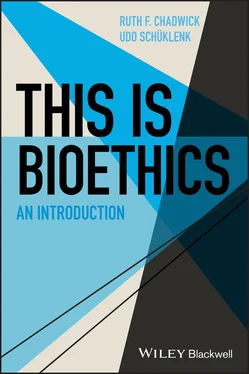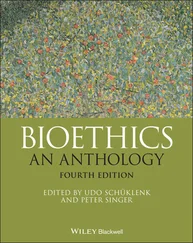2.22 Kant wasn’t particularly fond of our emotions and intuitions as the basis of our moral actions. He recognized that some of these intuitions and emotions could well result in our doing what is ethically required of us, say by our supporting the poor. However, he warns that just as well they could lead us astray, because they are not a result of our reason in analytical action. There certainly is some truth in this. Think for instance about Leon R. Kass, an influential bioethicist in the United States. Kass argued that certain views held in bioethics are clearly wrong, because they are repugnant. He argued, among others, that utilitarianism, human cloning and particular ways of eating ice cream were clearly wrong because they were repugnant. He wrote, ‘There is something deeply repugnant and fundamentally transgressive about such [destructive embryo experimentation] a utilitarian treatment of prospective human life’ (Kass 1997, 26).
2.23 Kass’ treatise on the Wisdom of Repugnance earned the scorn of many a bioethicist, not least because his line of reasoning arguably leads to arbitrary conclusions about what is right and what is wrong, based on who you ask about their feelings on a particular matter. To be fair to Kass, he advanced other arguments against human cloning that we will be looking at in Chapter 8. Still, strongly felt repugnance is indicative of a sound moral intuition to him.
2.24 Where would reason‐based ethics take us in terms of the formal structure of ethics? Kant insists it would take us to something he called the Categorical Imperative. There are slightly differing formulations of the Categorical Imperative, and not unexpectedly they have led to much scholarship generated by philosophers. That notwithstanding, the basic arguments underlying the Categorical Imperative are these: whatever moral rules we identify must be rules that are categorical, that is they are absolute, and they must be binding on us and everyone like us. Accordingly, these rules must be universal rules that we would be happy for all humans to follow them. Like utilitarians rule‐based philosophers think that we must not create rules just for ourselves.
2.25 Rule‐based ethics has been very influential in bioethics as well as political philosophy generally. Many an admonition in codes of medical ethics is rule‐based as opposed to consequentialist in nature. The idea that patient confidentiality must never be breached is an example of this; so is the idea that a doctor must never assist a patient who wishes to end her life. Among influential current day Kantian philosophers writing on bioethical issues are Frances Kamm 16 (e.g. 1992, 1994 and 1996) and Onora O’Neill 17 (e.g. 2002). We will hear more about their views throughout this book. Kantian philosophers also contributed 18 to US President George W. Bush’s Council on Bioethics 19 deliberations.
2.26 The Georgetown Mantra isn’t actually a mantra endorsed by Georgetown University, a Jesuit college in Washington DC. It’s a nickname describing arguably the most influential biomedical ethics textbook’s four‐principles’ approach to bioethical problem solving. It is often referred to as the ‘Georgetown Mantra’ because of its leading proponents’ close affiliation with Georgetown University. Tom Beauchamp and James Childress are the authors of Principles of Biomedical Ethics ; they developed this approach in successive editions of their popular textbook (2012). These authors do not claim to have developed a fully‐fledged ethical theory. However, they insist that four prima facie principles they have identified are widely recognized as sensible principles, even across cultures, and that they are compatible with various ethical theories. The Mantra combines consequentialist and deontological approaches to bioethics decision‐making. Essentially Beauchamp and Childress believe that four overarching principles suffice to address virtually every ethical problem that we are likely to encounter in bioethics.
2.27 The principles they propose are: non‐maleficence, beneficence, respect for autonomy and justice. Let us have a closer look at each of these principles and at how they interact with – and sometimes against – each other in order to get a better handle on the Georgetown Mantra. Keep in mind that these principles are considered prima facie by Beauchamp and Childress, that is – with good reason – every one of them can be overridden by competing stronger demands.
2.28 You might have heard of the often‐cited ‘first rule’ when it comes to health care practice: Primum non nocere – First do no harm. Non‐maleficence means little other than that. This principle is more strongly associated with Kantian thinking.
2.29 Beneficence requires health care professionals do to what is best by their patients. As we shall see, this can give rise to justifiable paternalistic actions by health care professionals. This principle is more strongly associated with consequentialist thinking.
2.5.3 Respect for Autonomy
2.30 This seemingly uncontroversial principle stipulates that the choices undertaken by competent, well‐informed patients should or even must be respected. In many jurisdictions this is reflected in law. In Canada, for instance, it would be illegal for a doctor to ignore a competent patient’s refusal of treatment, even if respecting those wishes would ultimately result in harm to the patient. Note that there is an in‐built conflict here between the first two principles and this principle.
2.31 The last principle is primarily concerned with fairness in the allocation of scarce resources, that is distributive justice 20 . This obviously is an important principle given the resource constraints faced by most health care systems. Initially we can reduce the idea of justice to a formal principle often ascribed to Aristotle: ‘Equals must be treated equally, and unequals must be treated unequally’ (Beauchamp 2019, 268). While uncontroversial, this formal principle doesn’t realistically help us when we are faced with distributive justice questions. We need to complement the formal principle with a material principle of justice, in other words, we need to move beyond the formal structure, and add substance to the principle. Once we do that though we are faced with a plethora of competing ideas about what justice entails, ranging from traditional communist, utilitarian to libertarian ideals as well as more recent ones such as those introduced by defenders of what is called the capabilities approach.
2.32 Justice then seems to be a thing that is very much in the eyes of the beholder, subject to the vagaries of one’s personal ideological convictions. A Marxist will hold a quite different view on resource allocation justice then a libertarian or a utilitarian (Takala 2001, 73). Finnish philosopher Tuija Takala quite nicely illustrates the problems with this principle by means of describing the political arguments political parties in Finland had during an election campaign:
In the spring of 1999, there was again in Finland the time for parliamentary elections. During the campaigns it became obvious that there was an overwhelming consensus among the rival parties that justice is important and that we should aim for a more just society. The only small difference between the parties was in the understanding of what justice is and what measures should be taken that justice would prevail. The right wing thought that by lowering the taxation of property and high salaries we would be able to do this. Meanwhile, the suggested solution from the left wing was to lower the taxation of the lower income groups and reaffirm the welfare rights, such as free education, free healthcare, and reasonable unemployment benefits. The political middle, representing the interests of agricultural Finland, reckoned that above all the government should fund the farmers. Same word, but different interpretations of what justly belongs to whom. Is it to everyone according to their need? An egalitarian principle to be found in Marxist thought as well. Or should we follow the libertarian idea of everyone owning their natural properties in good and in bad. If you happen to be faster, better, and smarter than the rest, you should have the benefits.
Читать дальше












